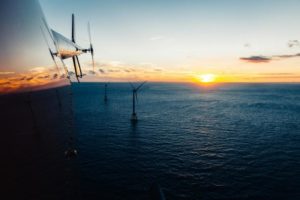The greatest challenge for mankind in the 21st century is powering the planet, while at the same time drastically reducing carbon emissions and continuing to lower the cost of energy. One year ago, GE published a Ecomagination report that examined the incredible acceleration of renewable energy development across the globe. We called upon businesses, investors and governments to further accelerate renewable energy innovation, build new solutions and create a truly sustainable energy ecosystem for the planet, its people and the world economy. Over the course of the year we learned that our optimism was well-grounded.
Some striking facts and figures — In 2016, wind and solar beat investment in fossil fuels by 2-to-1. Global capacity additions increased again in 2016; in the United States, renewable energy accounted for 60 percent of these additions. In 2016, Portugal powered the country with renewable energy alone for four consecutive days, clean power supplied Germany’s power demand for a full day, and Denmark could produce enough wind power to meet its domestic electricity demand and have enough to export power to Norway, Germany and Sweden. The U.K. generated more electricity by wind than coal – the first-time wind has outperformed coal for an entire year. In 2016, Hydro became visible as a storage solution and as an integrator of wind and solar. Small Hydro solutions grow as a source of electricity production close to the users. In 2016, the U.S. Department of Energy published a report stating that U.S. hydropower could grow from 101 gigawatts (GW) of capacity to nearly 150 GW by 2050.
We believe the business case for renewable energy remains strong today for several reasons:
First, the demand for new energy supplies around the world keeps growing at a significant pace. During the first half of 2016, clean energy investments reached $116.4 billion, and approximately $2 trillion is invested in the global energy sector per year.
Second, in many countries renewables can meet or even beat the cost of generation from conventional options. For example, in the United States onshore wind power is competitive with new natural gas-fired generation. Moving forward, GE’s research partner, the Joint Institute of Strategic Energy Analysis (JISEA) has estimated that by 2025, innovation will enable wind costs to fall by another 29 percent and solar PV costs to fall by up to 44 percent. Worldwide, Hydro is among the most competitive.
Image credit: GE Reports
Third, the renewable energy industry is a global jobs growth engine. Global renewable energy employment has reached 9.5 million and is increasing at a rate of 5 percent annually, which means that nearly 500 million new jobs are created every year. The greatest number of jobs are being created in the United States, China, Brazil, India, Japan and Germany.
There is scope for even more optimism. Technology innovation and policy commitments could lead to a world where wind energy accounts for one-third of electricity generation by the middle of the century. These are not “pie in the sky” estimates. Rather, they represent the range of what’s feasible given the current pace of innovation across the industry. Scientists at GE’s Global Research Center have developed innovations that place wind power on a pathway to produce power at 3 cents/kWh. Innovation is not confined to wind and solar power– innovations in hydropower promise to increase efficiencies in hydropower plants across the globe.
Innovations in hydropower efficiency are benefiting from the digital revolution. For example, GE’s Digital Hydro Plant is a unique blend of hydropower software and hardware, well-grounded in data analytics, and improving the performance of hydro plants across the globe. Data analytics provide greater accuracy about the performance of hydropower turbines, plants and equipment, which is helping control expenses and energy production.
The rapid pace of change in renewable energy is an exhilarating journey. We are seeing the evolution of new business models and power players. There are new investment opportunities – we can combine wind, solar and hydropower to change traditional energy models. Innovation in wind, solar, hydro, storage, hybrid technology, energy efficiency and digitization enable us to run the biggest economies and reach the most remote communities.
Just over 100 years ago, in a Scientific American advertisement, GE imagined a world where humankind could successfully harness the power of the sun, the wind and the sea. That vision, along with our relentless investment in technology innovation, has helped shape the renewable energy world that we live in today – imagine what the next 10 years will bring!
Debora Frodl is Global Executive Director at GE Ecomagination.
Yves Rannou is President and CEO for GE Renewable Energy, Hydro.
Original article by Yves Rannou & Debra Frodl via Manufacturing.net www.manufacturing.net/blog/2017/03/unstoppable-why-next-decade-belongs-renewable-energy

